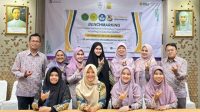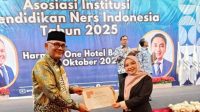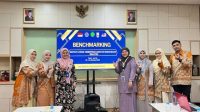
Jabartoday.com-Jakarta – In commemoration of the 97th Anniversary of the Youth Pledge on October 28, 2025, the Central Leadership Board of the Indonesian National Youth Committee (DPP KNPI) has emphasized the critical need to formulate and implement a National Grand Design for Youth Development. This blueprint is envisioned as a strategic roadmap towards achieving Golden Indonesia 2045.
The Chairman of DPP KNPI, Tantan Taufik Lubis, left no room for ambiguity regarding the need for a National Grand Design for Youth Development. “Let me be clear: building this grand design is not an option, but a strategic imperative and an absolute truth that demands urgent realization,” he asserted at the commemoration of the 97th Youth Pledge Anniversary. He framed this urgency within the context of Indonesia’s demographic bonus, warning that “the absence of a comprehensive master plan is not merely an oversight, but a strategic error that could have fatal consequences for the nation’s future.”
Linking this modern imperative to historical legacy, Tantan called for a renewal of the foundational spirit of the Indonesian youth movement. “The spirit of the 1928 Youth Pledge, which championed unity and noble ideals, must be continuously revitalized today,” he emphasized. He outlined a fundamental shift in national priorities, stating, “Our challenge has shifted from fighting for independence to building a superior civilization and winning global competition.” Because of this, he argued, empowering the younger generation is non-negotiable. “Therefore, understanding, empowering, and integrating youth into every line of national development is an absolute necessity.”
He elaborated on the unique role of the youth, describing them as “the axis of the nation’s hope,” a role built upon a trio of critical foundations: biological-intellectual potential, a strategic position in the nation’s history, and a moral responsibility for its sustainability. In today’s volatile world, he insisted that “Indonesian youth must not be mere spectators.” Instead, he called for a cohesive blueprint, stating that “Indonesia needs a comprehensive, systematic, and sustainable Grand Design for National Youth Development to serve as a compass for all elements of Indonesian youth to move in unison.”
Despite the passage of time, Tantan critiqued the lack of progress in this vital area. “Despite 80 years of independence and 97 years of the Youth Pledge, through numerous changes in the Minister of Youth and Sports, Indonesia is deemed to still lack an adequate concept for building its youth,” he lamented, adding a significant point of policy, “the existing Youth Law even requires revision.”
Furthermore, Tantan elaborated that this grand design must be built upon four integrated main pillars. First, the Character and Ideology Compass, which aims to shape youth who are rooted in the nation’s identity, possess integrity, and have mental resilience through contextual Pancasila education, revitalizing the meaning of national defense, and strengthening mental health and personal resilience. Second, the Capacity and Competitiveness Engine, which aims to create excellent youth human resources ready to compete globally by integrating “Merdeka Belajar” (Freedom to Learn) programs with the needs of future industries, building an innovation-based entrepreneurship ecosystem, and deepening digital skills such as AI and data analytics. Third, the Connectivity and Collaboration Nexus, which aims to broaden perspectives and networks through a national collaboration platform, inter-archipelago youth exchange programs, and leveraging the Indonesian young diaspora network. Fourth, the Participation and Leadership Arena, which aims to provide real space and trust for youth to lead by ensuring quotas in strategic institutions, funding youth-led development projects, and implementing tiered leadership training.
To strengthen its argument, KNPI also analyzed the successful implementation of grand designs for youth in several other countries. Singapore’s success with its National Youth Council demonstrates an impressive model of meritocracy and participatory empowerment, where the government acts as a facilitator. Vietnam exemplifies a approach of full integration with nation-building goals and strong character formation through massive youth organizations. Meanwhile, Malaysia shows the benefits of integration and centralization through the Malaysian Youth Council (MBM), which ensures effective coordination and avoids program overlap. From this comparison, at least three key lessons can be drawn: first, strong and sustained political commitment from the highest levels of government; second, effective, authoritative institutions with strong execution capacity; and third, meaningful participation where youth are involved as development partners from the planning phase to evaluation.
KNPI stressed that composing the National Grand Design for Youth Development is the largest and most strategic investment Indonesia can make today. It is the foundation for realizing Golden Indonesia 2045. Without it, the immense potential of over 64 million young people is threatened to be wasted, fragmented, and directionless. Delaying the construction of this grand design risks squandering the potential of an entire generation and turning the demographic bonus into a “demographic disaster.” The window of opportunity offered by the demographic bonus is a rare, one-time phenomenon; sluggishness in designing and implementing this grand design is no longer just a mistake, but a massive squandering of the greatest human capital Indonesia has ever possessed.
In closing, the Central Leadership Board of the Indonesian National Youth Committee invited all stakeholders and components of the nation, from the government and business world to academia and civil society, to jointly support the formulation and realization of this National Grand Design for Youth Development. “The 97th Anniversary of the Youth Pledge on October 28, 2025, is the starting point. Let us realize Golden Indonesia 2045 by making youth the backbone and the locomotive of development. United Youth, Golden Indonesia Realized,” declared Tantan. [FZF]






